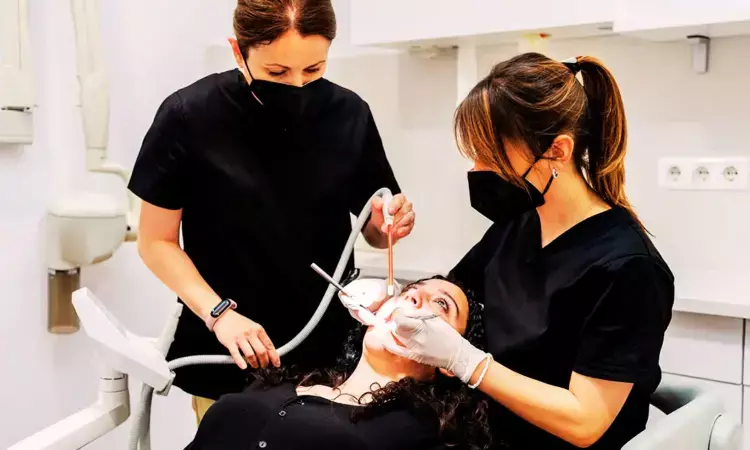- Home
- Medical news & Guidelines
- Anesthesiology
- Cardiology and CTVS
- Critical Care
- Dentistry
- Dermatology
- Diabetes and Endocrinology
- ENT
- Gastroenterology
- Medicine
- Nephrology
- Neurology
- Obstretics-Gynaecology
- Oncology
- Ophthalmology
- Orthopaedics
- Pediatrics-Neonatology
- Psychiatry
- Pulmonology
- Radiology
- Surgery
- Urology
- Laboratory Medicine
- Diet
- Nursing
- Paramedical
- Physiotherapy
- Health news
- Fact Check
- Bone Health Fact Check
- Brain Health Fact Check
- Cancer Related Fact Check
- Child Care Fact Check
- Dental and oral health fact check
- Diabetes and metabolic health fact check
- Diet and Nutrition Fact Check
- Eye and ENT Care Fact Check
- Fitness fact check
- Gut health fact check
- Heart health fact check
- Kidney health fact check
- Medical education fact check
- Men's health fact check
- Respiratory fact check
- Skin and hair care fact check
- Vaccine and Immunization fact check
- Women's health fact check
- AYUSH
- State News
- Andaman and Nicobar Islands
- Andhra Pradesh
- Arunachal Pradesh
- Assam
- Bihar
- Chandigarh
- Chattisgarh
- Dadra and Nagar Haveli
- Daman and Diu
- Delhi
- Goa
- Gujarat
- Haryana
- Himachal Pradesh
- Jammu & Kashmir
- Jharkhand
- Karnataka
- Kerala
- Ladakh
- Lakshadweep
- Madhya Pradesh
- Maharashtra
- Manipur
- Meghalaya
- Mizoram
- Nagaland
- Odisha
- Puducherry
- Punjab
- Rajasthan
- Sikkim
- Tamil Nadu
- Telangana
- Tripura
- Uttar Pradesh
- Uttrakhand
- West Bengal
- Medical Education
- Industry
Pulp canal obliteration and calcification more common in females on opposite side of proximal caries: Study

Recent study has found that proximal caries in mandibular molars are associated with significant calcification, or pulp canal obliteration (PCO), in the contralateral root canal. The new study of CBCT scans done recently looked into the prevalence and pattern of PCO in the molars of patients with proximal caries, showing that the amount of calcification typically occurs on the opposite side of the root canal on which caries are visible. The study was conducted by Ganesh R. and colleagues and was published in the Journal of Endodontics.
Dental caries remain a very common oral health problem, generally resulting in pulp tissue inflammation and other sequelae. Proximal caries, those occurring between two adjacent teeth, may often present a therapeutic challenge due to the limited mobility of the affected tooth. In mandibular molars, these caries are often accompanied by PCO - a calcification process that might hinder blood supply, impair root health, and complicate root canal procedures. The present study aimed to determine how the location of proximal caries relates to the site and degree of PCO and any differences among age, gender, and position of caries.
A total of 1,491 CBCT scans of dental patients aged 18 to 49 years old from the period of 2002 to 2022 were analyzed. Out of these, 328 teeth showing visible proximal caries were chosen using the defined inclusion criteria for more thorough examination. The studied teeth for both calibrated examiners were scored for PCO presence and severity along the sagittal and coronal planes. Comparisons of data were conducted on the basis of alterations in presence and PCO severity with respect to age, sex, and caries location by independent sample t-test.
• Among patients with proximal caries, PCO was observed in 47% of cases, underscoring its common occurrence in caries-affected mandibular molars.
• Proximal caries in the mesial (front) position correlated with greater PCO in the distal root canal (73.4%). Conversely, distal caries led to increased PCO in the mesial canal, affecting 77.3% of cases.
• The mean level of intraradicular calcification was significantly higher in the distal canal compared to the mesial canal (p< 0.001).
• PCO occurrence was significantly more common in female patients than males, with females showing a higher likelihood of developing PCO (p=0.003).
The study validated that proximal caries in mandibular molars are observed to have a high incidence of calcification on the contralateral side of the root canal. The prevalence of this calcification was more prominent at the distal side of the canals. This may lead to improving the accuracy of diagnosis and consequently the outcome for patients in dental practice.
Reference:
Dr Riya Dave has completed dentistry from Gujarat University in 2022. She is a dentist and accomplished medical and scientific writer known for her commitment to bridging the gap between clinical expertise and accessible healthcare information. She has been actively involved in writing blogs related to health and wellness.
Dr Kamal Kant Kohli-MBBS, DTCD- a chest specialist with more than 30 years of practice and a flair for writing clinical articles, Dr Kamal Kant Kohli joined Medical Dialogues as a Chief Editor of Medical News. Besides writing articles, as an editor, he proofreads and verifies all the medical content published on Medical Dialogues including those coming from journals, studies,medical conferences,guidelines etc. Email: drkohli@medicaldialogues.in. Contact no. 011-43720751


